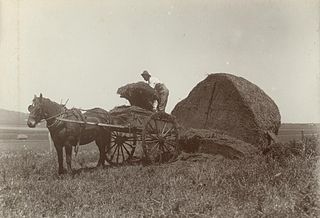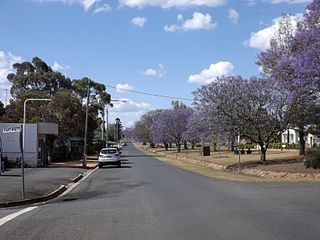
Drayton is a rural locality in the Toowoomba Region, Queensland, Australia. In the 2021 census, Drayton had a population of 1,813 people.
Glenvale is a semi-rural residential locality in the Toowoomba Region, Queensland, Australia. It is a suburb of Toowoomba. In the 2021 census, Glenvale had a population of 8,120 people.

Meringandan is a rural locality in the Toowoomba Region, Queensland, Australia. In the 2016 census, Meringandan had a population of 487 people.

Kingsthorpe is a rural town and locality in the Toowoomba Region, Queensland, Australia. In the 2021 census, the locality of Kingsthorpe had a population of 2,159 people.

Bowenville is a rural town and locality in the Toowoomba Region, Queensland, Australia. The town's economy rested on the rail industry and with the winding down of the railways the population declined. In the 2016 census, the locality of Bowenville had a population of 250 people.

Goombungee is a rural town and locality in the Toowoomba Region, Queensland, Australia. In the 2016 census the locality of Goombungee had a population of 1,026 people.
Cotswold Hills is a rural-residential locality within Toowoomba in the Toowoomba Region, Queensland, Australia. In the 2021 census, Cotswold Hills had a population of 1,620 people.
Cranley is a rural locality in the Toowoomba Region, Queensland, Australia. In the 2021 census, Cranley had a population of 2,281 people.

Charlton is a rural locality in the Toowoomba Region, Queensland, Australia, located 13 kilometres (8 mi) west from the Toowoomba city centre off the Warrego Highway.. In the 2021 census, Charlton had a population of 107 people.

Wellcamp is a rural locality in the Toowoomba Region, Queensland, Australia. In the 2021 census, Wellcamp had a population of 346 people.

Rockville is a residential locality in the Toowoomba Region, Queensland, Australia. In the 2021 census, Rockville had a population of 3,204 people.

Aubigny is a rural town and locality in the Toowoomba Region, Queensland, Australia. In the 2016 census, the locality of Aubigny had a population of 254 people.

Glencoe is a rural locality in the Toowoomba Region, Queensland, Australia. In the 2021 census, Glencoe had a population of 304 people.

Boodua is a rural locality in the Toowoomba Region, Queensland, Australia. In the 2021 census, Boodua had a population of 95 people.

Gowrie Little Plain is a rural locality in the Toowoomba Region, Queensland, Australia. In the 2021 census, Gowrie Little Plain had a population of 79 people.

Gowrie Mountain is a locality in the Toowoomba Region, Queensland, Australia. In the 2021 census, Gowrie Mountain had a population of 222 people.

Silverleigh is a rural locality in the Toowoomba Region, Queensland, Australia. In the 2021 census, Silverleigh had a population of 80 people.

Yarranlea is a rural locality in the Toowoomba Region, Queensland, Australia. In the 2021 census, Yarranlea had a population of 82 people.
Cutella is a rural locality in the Toowoomba Region, Queensland, Australia. In the 2021 census, Cutella had a population of 45 people.
Kings Siding is a rural locality in the Toowoomba Region, Queensland, Australia. In the 2021 census, Kings Siding had a population of 15 people.
















